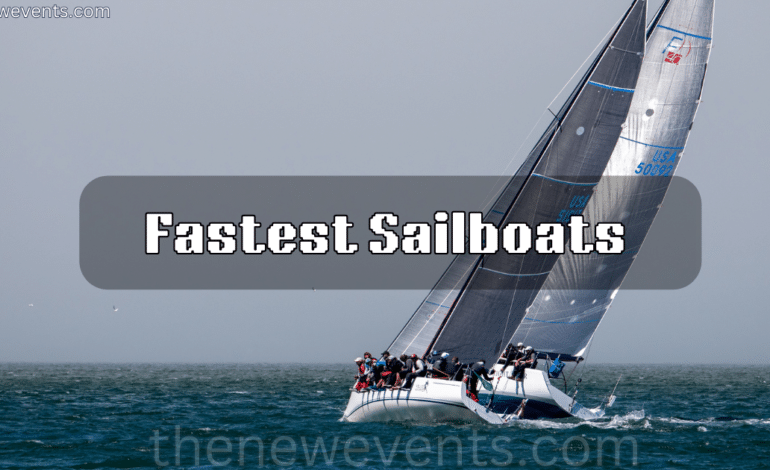What Are The Fastest Sailboats?-Complete List

Sailing has always been synonymous with adventure and innovation. Over centuries, advancements in technology and design have pushed the boundaries of what sailboats can achieve. Today, some sailboats can rival motorized vessels in speed while offering a unique and thrilling experience. In this article, we explore the fastest sailboats in the world, the technology behind their incredible speeds, and what makes them stand out.
Key Takeaway :What Are The Fastest Sailboats?-Complete List
- Record-Breaking Speed: The Vestas Sailrocket 2 holds the title of the fastest sailboat in the world, reaching an astonishing 65.45 knots (75.2 mph).
- Hydrofoil Technology: Many of the fastest sailboats, such as Hydroptère and SailGP F50 catamarans, utilize hydrofoils to lift the hull above the water, drastically reducing drag and enhancing speed.
- Innovative Designs: Speedboats like the AC75 America’s Cup vessels and Macif Ultim trimarans showcase cutting-edge designs, including advanced sail configurations, lightweight materials, and aerodynamic features.
- Diverse Applications: While some sailboats, like Vestas Sailrocket 2, are built exclusively for breaking speed records, others like Comanche and Wild Oats XI excel in offshore racing and long-distance competitions.
- Technological Advancements: Modern sailboats incorporate carbon fiber composites, computer-aided designs, and state-of-the-art navigation systems, setting new standards for speed and efficiency in sailing.
Understanding Sailboat Speed
The speed of a sailboat depends on several factors, including its design, the wind conditions, and the skill of the crew. Here are some key design features that contribute to speed:
- Hull Design: A narrow, lightweight hull reduces drag and allows the boat to glide through the water efficiently.
- Sail Configuration: Advanced sails made from high-performance materials like carbon fiber capture wind more effectively.
- Hydrofoils: Modern sailboats often use hydrofoils, which lift the hull above the water to reduce drag and increase speed.
- Materials: Lightweight materials like carbon fiber and composites enhance performance while maintaining structural integrity.
Now, let’s dive into the list of the fastest sailboats in the world.
1. Vestas Sailrocket 2
The Vestas Sailrocket 2 holds the record for being the fastest sailboat in the world. Designed specifically to break speed records, this unique vessel achieved a top speed of 65.45 knots (approximately 75.2 mph) in 2012.
Features:
- Innovative Design: Its asymmetrical configuration minimizes drag and maximizes thrust.
- Hydrofoil Technology: The use of hydrofoils lifts the boat out of the water, reducing friction.
- Purpose-Built: Every aspect of the Sailrocket 2 was designed to optimize speed, making it unsuitable for recreational sailing but perfect for setting records.
2. Hydroptère

Hydroptère, a French-designed sailboat, is one of the most iconic speed sailing vessels. It achieved a speed of 56.3 knots (about 64.8 mph) in 2009.
Features:
- Tri-Hull Configuration: This trimaran design combines stability with speed.
- Foiling System: Hydrofoils lift the boat out of the water, significantly reducing drag.
- Pioneering Design: Hydroptère’s success paved the way for modern foiling technology in sailboats.
3. Syroco (Under Development)
Syroco is an ambitious project aiming to surpass the Vestas Sailrocket 2’s record. Although still under development, it’s designed to achieve speeds exceeding 80 knots (about 92 mph).
Features:
- Groundbreaking Design: Combines cutting-edge aerodynamics and hydrodynamics.
- Data-Driven: Incorporates advanced simulations to refine performance.
- Record-Breaking Potential: If successful, Syroco could redefine speed sailing.
4. Macif Ultim (Trimaran)

The Macif Ultim trimaran is one of the fastest offshore sailboats in the world. It has reached speeds of over 40 knots (about 46 mph) and holds records for transatlantic crossings.
Features:
- Gigantic Size: At 30 meters (98 feet) long, it’s built for offshore speed.
- Carbon Fiber Construction: Ensures both strength and lightweight performance.
- Advanced Autopilot: Uses technology to optimize speed and stability during long voyages.
5. Comanche
Comanche is a monohull sailboat designed for breaking records in offshore racing. It has a top speed of 30 knots (about 34.5 mph) and has set numerous records, including the fastest transatlantic crossing by a monohull.
Features:
- Wide Beam: Provides stability and allows for larger sail areas.
- Lightweight Build: Made from high-tech composites for optimal performance.
- Racing Pedigree: Comanche is a dominant force in global sailing races.
6. IDEC Sport (Trimaran)
IDEC Sport is a high-performance trimaran known for breaking world sailing records, including circumnavigation. It has reached speeds of 38 knots (about 43.7 mph).
Features:
- Modular Design: Adaptable for various types of racing.
- Efficiency: Designed to maintain high speeds over long distances.
- Crew Excellence: Operated by some of the world’s best sailors.
7. Banque Populaire V (Trimaran)
Banque Populaire V is another trimaran designed for extreme speed. It holds the record for the fastest circumnavigation of the globe, achieving an average speed of 26.5 knots (about 30.5 mph).
Features:
- Massive Size: At 40 meters (131 feet) long, it’s one of the largest trimarans ever built.
- Record-Setter: Holds multiple speed records, including the Jules Verne Trophy.
- Advanced Navigation Systems: Enhances efficiency and speed over long distances.
8. SailGP F50 Catamarans
The F50 catamarans used in the SailGP racing series are some of the fastest competitive sailboats, reaching speeds of 53 knots (about 61 mph).
Features:
- Foiling Technology: Hydrofoils lift the boats for reduced drag.
- High-Tech Design: Incorporates aerodynamic sails and lightweight materials.
- Competitive Racing: Designed for short, high-intensity races.
9. AC75 America’s Cup Boats

The AC75 class boats, used in the America’s Cup, are cutting-edge monohulls capable of reaching speeds of over 50 knots (about 57.5 mph).
Features:
- Foiling Monohulls: Combines the stability of monohulls with the speed of hydrofoils.
- Innovative Sails: Wing-like sails provide exceptional aerodynamic efficiency.
- Technological Marvels: Showcase the latest in sailing innovation.
10. Wild Oats XI
Wild Oats XI is a legendary maxi yacht known for dominating the Sydney to Hobart Yacht Race. It has achieved speeds of 25 knots (about 28.8 mph).
Features:
- Optimized for Racing: Combines speed, agility, and reliability.
- Carbon Fiber Mast: Reduces weight while increasing strength.
- Record Holder: Holds numerous records in offshore racing.
The Technology Behind Fast Sailboats
Modern sailboats achieve incredible speeds through advanced technology and design innovations. Here are some key elements:
- Hydrofoils: Lift the boat above water, reducing drag and increasing speed.
- Composite Materials: Lightweight and strong materials like carbon fiber improve performance.
- Advanced Aerodynamics: Wing-shaped sails and streamlined hulls enhance efficiency.
- Computer-Assisted Design: Simulations optimize designs for speed and stability.
Also Read : What Sailboats Are Made In The USA?
Conclusion
The fastest sailboats in the world are a testament to human ingenuity and the relentless pursuit of speed. From record-breaking hydrofoils like the Vestas Sailrocket 2 to competitive racing machines like the AC75, these boats push the boundaries of what’s possible on water. As technology continues to evolve, the quest for even greater speeds shows no signs of slowing down. For sailing enthusiasts, these vessels are not just modes of transport—they are marvels of engineering and symbols of the spirit of adventure.
FAQs
1. What is the fastest sailboat in the world?
The Vestas Sailrocket 2 is the fastest sailboat, achieving a speed of 65.45 knots in 2012.
2. What is hydrofoiling in sailboats?
Hydrofoiling involves using underwater wings (hydrofoils) to lift the hull above water, reducing drag and increasing speed.
3. How fast can modern racing sailboats go?
Modern racing sailboats, like the SailGP F50 catamarans, can reach speeds exceeding 50 knots (about 57.5 mph).
4. Are fast sailboats suitable for recreational use?
Some fast sailboats, like trimarans and monohulls, are designed for recreational sailing, but record-breaking vessels like the Sailrocket are purpose-built for speed and not practical for casual use.
5. What materials are used to make fast sailboats?
Fast sailboats are typically made from lightweight and strong materials like carbon fiber, composites, and advanced resins.





